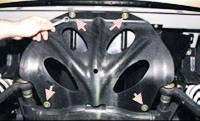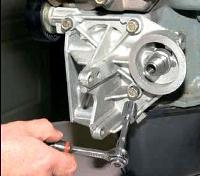The minimum allowable thickness of the friction linings of the brake pads is 1.5 mm. Replace pads in the following cases:
- – overlay thickness less than 1.5 mm;
- - the surface of the overlays is oily;
- - overlays are loosely connected to the base;
- - overlays have deep grooves and chips.
If for some reason you removed the front wheel, check the condition of the pads through the hole in the caliper housing.
If the thickness of the friction linings is about 2 mm, replace the pads.
If the car pulls to one side or makes noise when braking, remove the brake pads and check their condition.
You will need: jack, wheel chocks, screwdriver, pliers, drift, metal brush, hammer.
Loosen and tighten the wheel nuts only when the vehicle is on the ground.
Do not use gasoline, diesel fuel or any other mineral solvents to clean the brakes.
The pads must be replaced in the brake mechanisms of both front wheels at the same time.
It is not allowed to replace the inner and outer pads with each other, as well as between the left and right wheels. This can lead to uneven braking.
- 1. Apply the parking brake and chock the rear wheels.
- 2. Remove the front wheel.
- 3. Clear the brake mechanism of dirt. To facilitate disassembly, apply liquid like WD-40 to the joints of the fingers with the caliper and clamping levers.
- 4. Pump out part of the fluid from the reservoir if the brake fluid level in the reservoir is at or close to the “MAX” mark before replacing the pads.
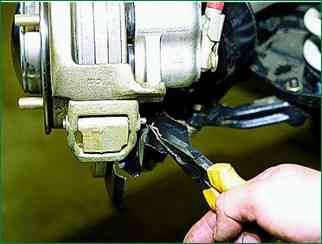
Pliers take out the cotter pin of the lower axis of the clamping lever.

With a drift we cut the axis of the clamping lever
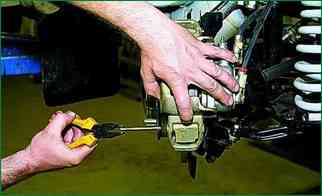
Holding the lever, take out the axle with pliers.
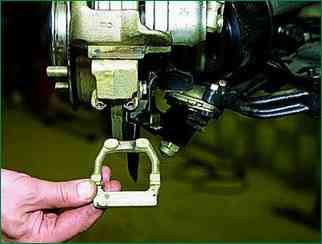
Remove the pressure lever.
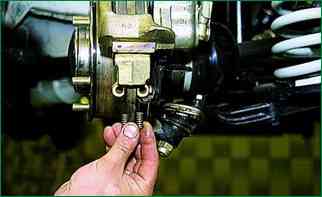
We take out two springs of the pressure lever from the guide pads so as not to lose them
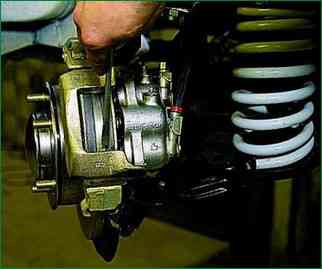
Having prying with a screwdriver, lift the brake caliper and put it on the steering knuckle.
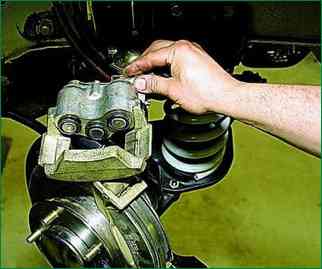
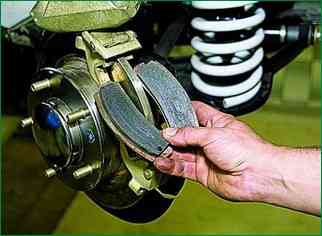
We remove the brake pads from the guide.

Before installing new brake pads, the pistons must be moved as far into the cylinders as possible.
With sliding pliers (or a gas wrench), we press the pistons into the cylinders.
Pistons can be sunk into cylinders in another way.

To do this, we insert the outer pad into the guide and, having installed the caliper in place, press the pistons into the cylinders with a mounting blade
Then we assemble the node in the reverse order.

To facilitate the installation of the axis of the pressure lever, we sharpen its tip on the sharpener so that we get a cone.
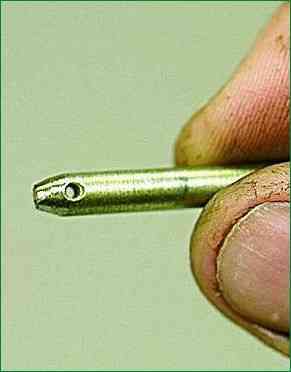
Before installation, the axis of the clamping lever is lubricated with graphite grease
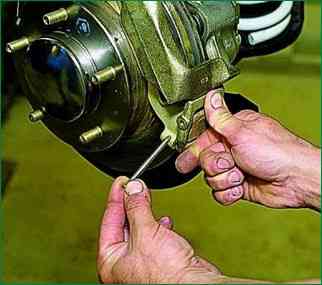
Pressing the lever, insert the axle
After installing the brake pads, you need to press the brake pedal several times so that the pistons of the cylinders bring the pads to the brake disc.
Check the brake fluid level in the reservoir and top up if necessary.
After replacing worn-out brake pads with new ones, do not rush to immediately drive onto busy highways.
It is possible that at the very first intensive braking you will be unpleasantly surprised by the low efficiency of the brakes, although the pads were branded.
Brake discs also wear out, and new pads only touch them at the edges, practically without braking.
Choose a quiet street or passage without cars and slow down gently several times so that the pads get used and fit the entire surface.
At the same time, evaluate the effectiveness of the brakes. And try not to brake sharply for at least the first 100 km.
If the unprocessed pads are very hot, the top layer of their pads burns and the brakes will not be as effective as possible for a long time.









